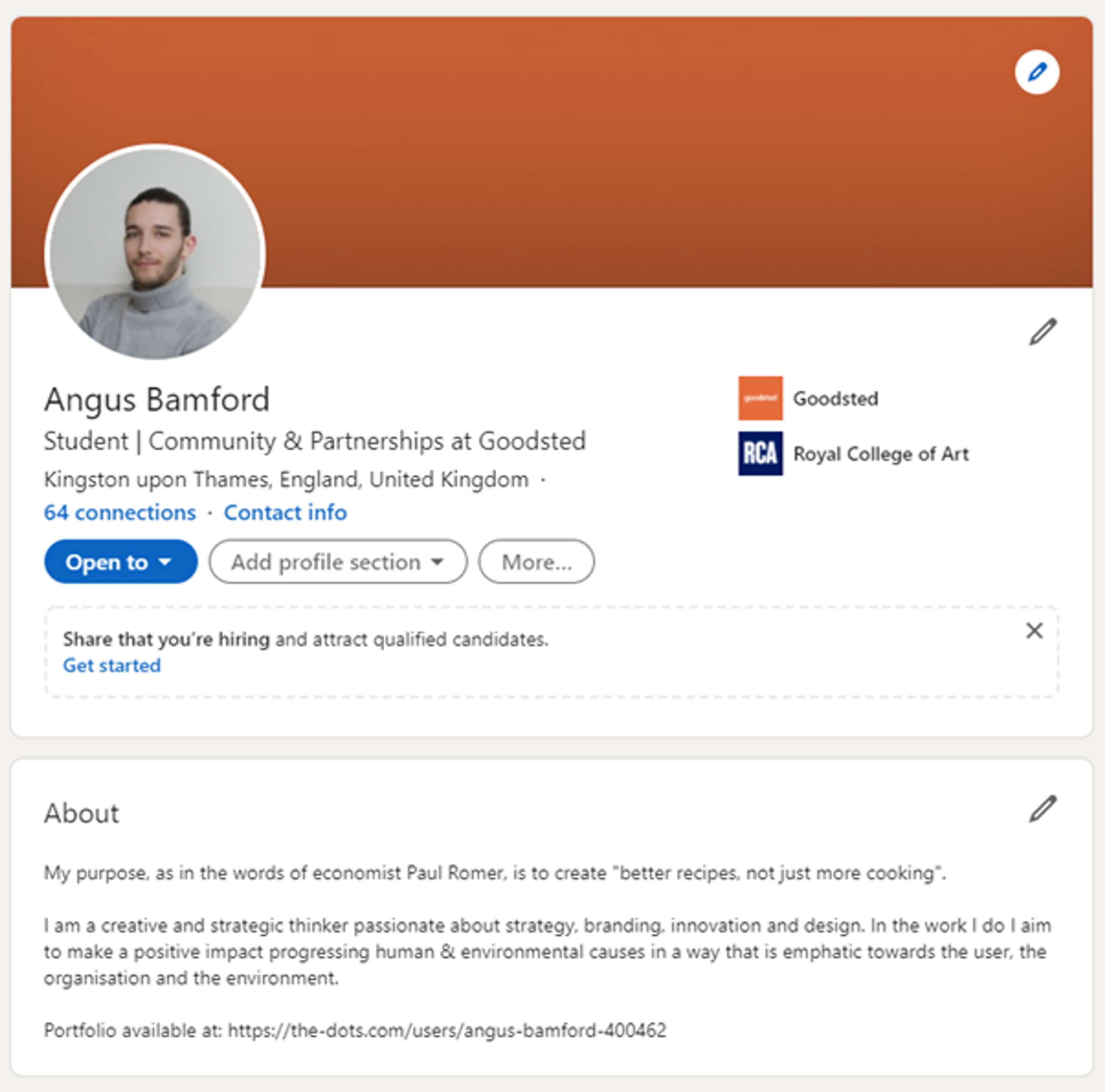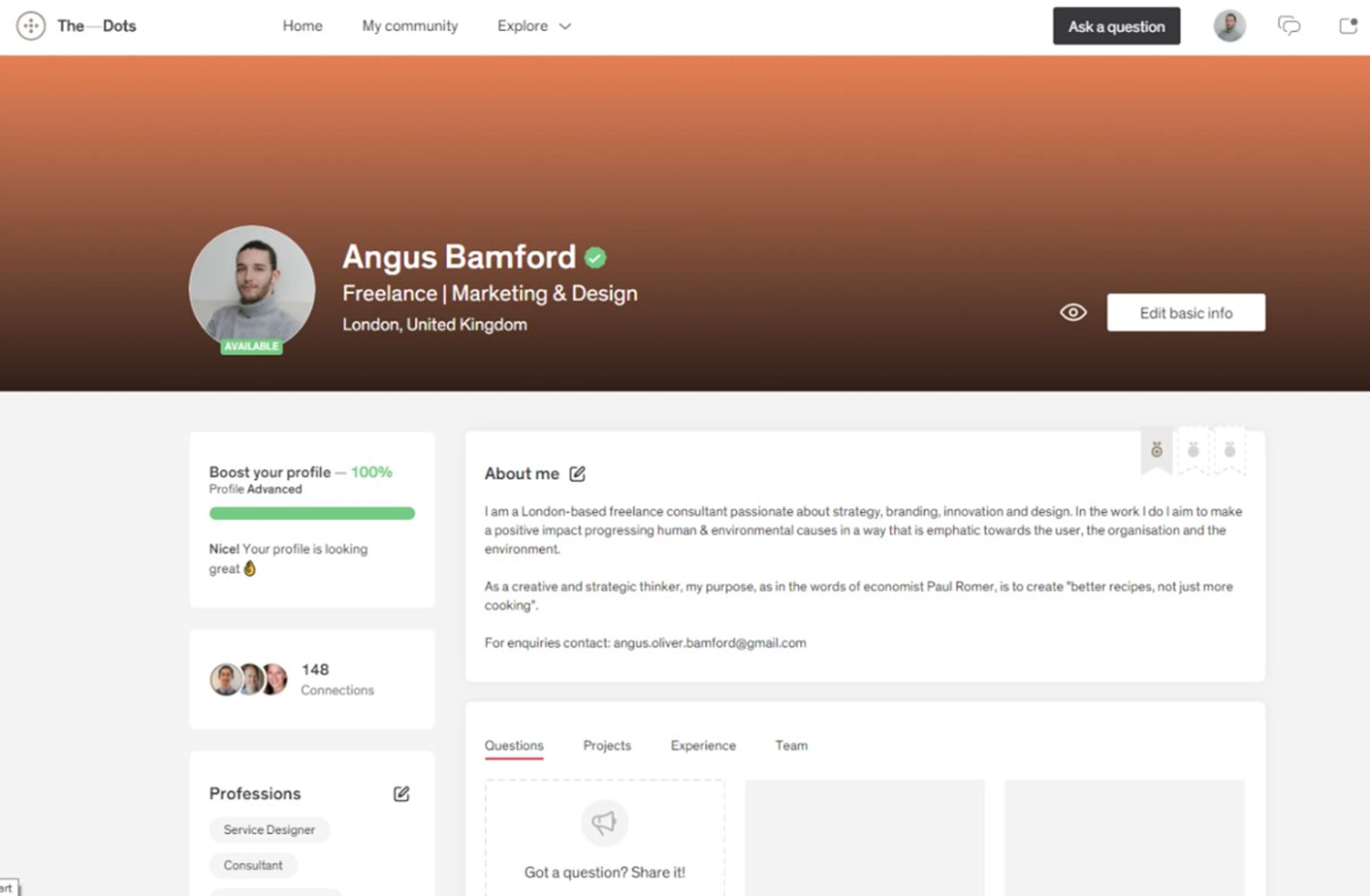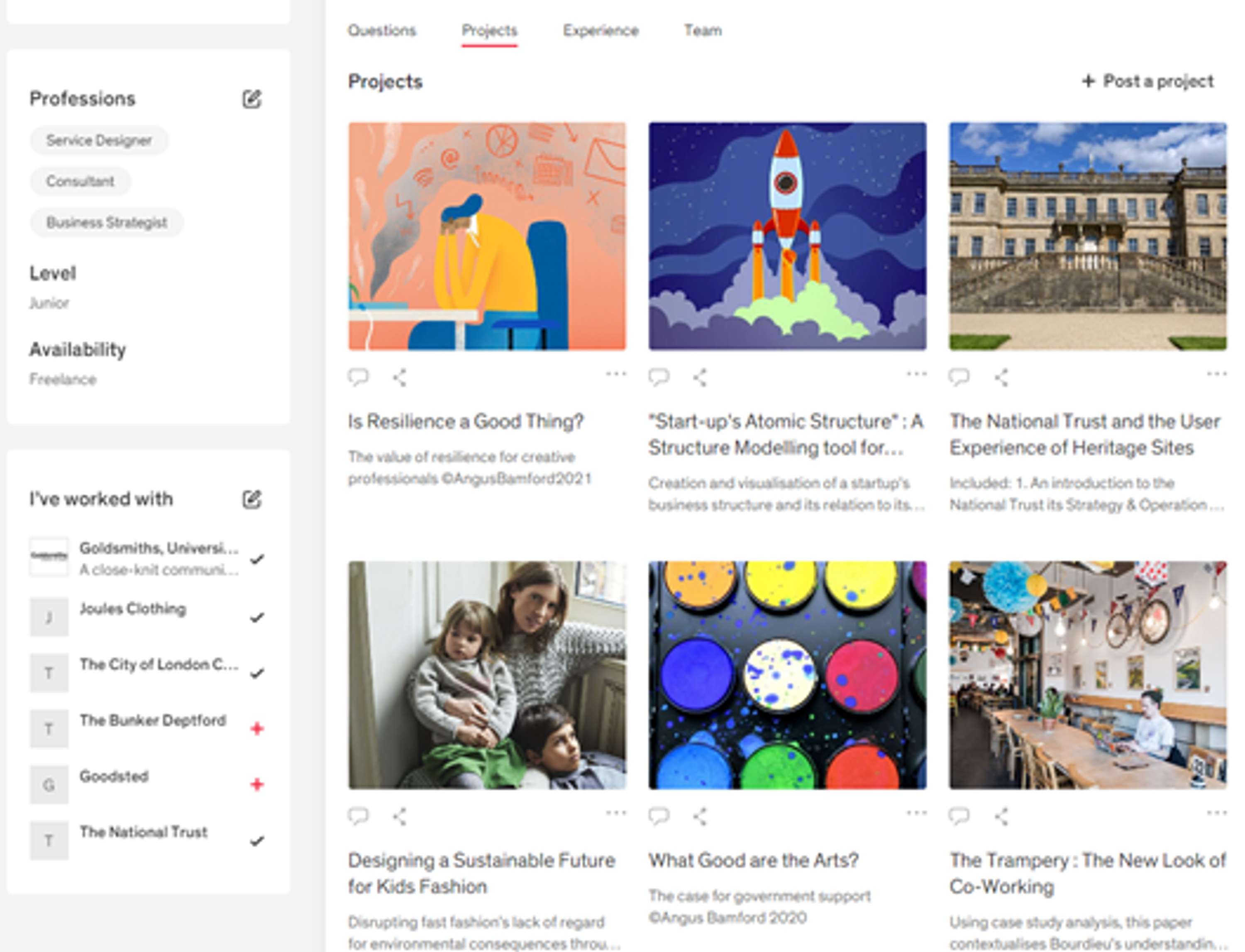A Creatives Digital Presentation of Self
A reflective piece of Erving Goffman’s 1959 dramaturgical approach applied to the digital social establishment. I discuss myself as an emerging creative professional and my usage of digital professional networks LinkedIn and The Dots as investigatory case studies to identify, unpack and evaluate the digital presentation of self and the value of LinkedIn and The Dots for the creative professional. Divided into two sections: discourse analysis and applications. The discourse analysis provides the context to the findings and reflections identified in the application.
Discourse
In today’s digitised world the presentation of self through social media platforms is truly a part of everyday life, however, unlike in Goffman’s assessment with the digitalised social establishment, there is no more security in the curtain and backstage. One’s true self is exposed to the same audience and its implications as our performative frontstage self.
Goffman’s dramaturgy
Goffman in his 1959 book The Presentation of Self in Everyday Life used theatrical production as a metaphor likening social interaction to the theatre. The actor or individual can be the performer, audience, even outsider that operates within particular stages or social spaces’. Any interaction between the actor and audience contains 'sign-vehicles' or carriers of information in which individuals act whether intentionally or unintentionally as an expression of self, and the other or audience will, in turn, be impressed.
Goffman argues these impressions involve two sign-vehicles: the expression that they gives, and the expression that they gives off. The first being the ‘intentioned conveying of information and the latter being that which is symptomatic of the actor or the unintentional expressions. What is critical to the argument is that these conveying’s of information’s are latent in misinformation, the first involving deceit, the second feigning. Collectively these communications forge the character that is then accepted in faith and is thus judged by the audience.
“Regardless of the particular objective which the individual has in mind and of their motive for having this objective, it will be in their interests to control the conduct of the others, especially their responsive treatment of the” (Goffman)
In Goffman's conceptualisation of the stage as the social space with every production or interaction, there is a front and backstage and each serves its purpose in differentiating the private and public, and to what the individual wishes to both perform and conceal as with a metaphorical curtain. The audience is at least in Anglo-American society respectful of this division as a normative behaviour of the social establishment.
Social media and the self
The term ‘mass self-communication' refers to the globalised system of interaction networks that served the performance of an online identity. The goal for social media networks is to have digital affordances replicate complex social interactions, increasing scale and accessibility to almost unlimited potentials. Furthermore, in study of Facebook, research inferred that the value of the platform is in being the ‘backstage’ itself. This achieved by the collection of data attributing the personal identity to which otherwise is not performed or frontstage, offering a more truer sense of self. Such's normalisation within society has dissolved the curtain, as social media has perpetuated the social requirements to expose the self through requiring the ‘creating, sharing and continually updating of a publicly accessible digital footprint’ laced with personal information to simply have a digital social presence even quiescent. Moreover, in the digital space our identity is both of our curations; thus ownership, and as of exploitation by the other. To this, in the digital space we are the sum total of our data… and therefore our existence becomes precarious since data (unlike memories) can be taken from us and used in ways we do not intend. For example likes and comments leads to increased scrutiny and alterations of self-presentation as well as also the economic exploitation in the selling of personal data to advertisement.
Although social media is truly an opened pandora's box of amazed innovations unbelieved just fifty years ago, with the access to digital footprints and personal information, the digital presentation of self has become primordial to the curation, understanding and interpreting of who we are both performatively and in actual and thus essential to one's engagement in the modern social establishment, including me. Although our understanding of the implications of digital on the self is limited even misconstrued, there are growing requirements for discourse around the implications of the coding, algorithm and design of social media platform and how it implicates the self, in ways such as our mental health and professional development. It is because of this I felt compelled to understand how such implicates my own presentation of self, and therefore also could be applied to support fellow creative professionals using digital tools of self-presentation.
Self Applications
In this section I will discuss I as a creative professional, its broader relation to the presentation of self and my LinkedIn and Dots usage.
I as a creative professional
The creative professional, which I identify as and have previously self-defined ‘consists of persons with many interests and creative pursuits and display aptitudes across multiple disciplines, broadly within the knowledge industry. They within neo-liberal societies lie somewhere on a spectrum between the arts (creative) and business (professional) and are, therefore, impacted by industry forces in a multi-faceted way. Within creative professional communities, a trend impacting the digital social establishment is digital nomadicity. This refers to the mobile knowledge worker equipped with digital technologies to work anytime, anywhere most of which are freelance or within SME’s or microbusinesses. In the digital social establishment as a response to remote working, the side-hustle and individualism, the ‘attention economy’ has been exacerbated as with a growing global and digitised world, accessibility and scale increases, thus the competitive forces for attention. Further relating to the attention economy, with the rise of the micro-celebrity, the so-called ‘ordinary person’ is enabled the tools (social media) to exploit their self as means of entering a certain industry without per se the traditional gatekeepers, and therefore also increases the competitive forces. This is particularly consequential to the creative professional as the rise of Instafame and contemporarily the TikTok artist has enabled artistic work production for the masses. such enabling bypasses the creative professional's traditional industry intermediaries and blurring the lines between the social digital affordance and the professional. What is apparent is that the digital self has more direct implications on the creative professional’s livelihood than per se a corporate employee professional; as their own professional brand is in affiliation to the firm. Therefore, to conclude as a response to both changes to professional spaces and this growing attention competitiveness the creative professional is more than ever been required to invest in a digital presentation self and one’s branding. Why? as it implicates opportunities, social connectivity and professional reputation and ultimately wealth and wellbeing for the creative professional in the Anglo-American societal structure.
As an emerging creative professional within the UK context, the requirements above are more so than something I believe to be of value but further as a Gen-Z a part of my everyday life. It is ultimately second-nature to me and my peers that you have a digital presence as essential ‘to see and be seen’.
LinkedIn, The Dots and I
Using LinkedIn and The Dots as case examples enables the investigating of Goffman’s theory and how both digital affordances implicate my presentation of self and also how I exploit LinkedIn and The Dots to compete and be seen as a creative professional
LinkedIn
With a substantial usership of 720million, LinkedIn is the largest professional matchmaking service in the world.
LinkedIn is in the words of Jeff Weiner, CEO of LinkedIn (in interview 2010):
“a professional network… The key distinction is that as a professional you want to know who you are. People are searching for you or people like you whether you like it or not”

As a creative professional, LinkedIn facilitates the ‘professional’ in my identity and is, therefore, the most relational aspect to my economic prospects, as a means of illustrating my professional capabilities beyond the ‘creative’. As an emerging creative professional, I have both a creative portfolio and the professional portfolio, this is not uncommon amongst my peers of Arts Management however having a professional presence has growingly permeated emerging creatives practitioners in Crafts and Fine Art for example as well. Although for the creative practitioner it is less desirable due to the corporate connotations of LinkedIn as well as arguably political and social isolation from LinkedIn; with it being a marketplace significantly occupied by middle-aged, high earning male corporate professionals. Ultimately for the creative LinkedIn’s targeting of corporate professionals creates a less inviting platform for those who do not assimilate into the hustle working mentality of which dictates the design and interactions of LinkedIn. However, LinkedIn by showing off social as well as professional skills, actually increases a user’s professional value on the job market, enabling the transferring of creative skills into economic value for creative professionals and super creative core also, if curated with such intention.
Is LinkedIn effective in building the economic potentials of creative professionals? With no available data on the matter subjectively it is debatable whether LinkedIn is directly a valid tool in building the economic potentials of creative professional. However, as social relationships are central to value production, the social network for the professional is a part of their production of value. This is because immaterial labour; of which much creative labour now produces, is reliant on the valorisation of subjectivity. LinkedIn facilitates such subjective impression management and accumulates social capital by integrating connectedness with connectivity and narrative logic with database analytics. The act of impression management through LinkedIn creates the mystique and builds social capital to which the economic value of the labour is believed in ‘faith’.
A second challenge is whether LinkedIn is inviting or serving of the creative professional? Given its lack of portfolio showcasing and being performative with the posting of accoladed and endorsements by leveraging existing networks, LinkedIn is something more susceptible to the corporate professional rather than creative, however, the growth of the emerging creative professional in the LinkedIn space is relational to the ever-in-demand creative professional in the corporate landscape. As the creative professional's labour or skills is growing valued in supplementary and commercial labour markets, under occupations such as Advertisement, Design, even Management, creative professionals now have greater access to exploit the economic value within the corporate world. Richard Florida identified that those within the creative class (a grouping aligned with the above occupations and my definition of the creative professional) typically earned in the US an average hourly wage of $23.44, whereas an artistic practitioner (e.g. dancer or sculptor) known as the super-creative core typically earns $20.54 and the total US workforce $15.18. Therefore as creativity is highly valued the presentation of one's creativity through LinkedIn using impression management can lead to enhanced value perception from the audience. When describing myself (seen in figure 1), using an economist quotation followed by a statement of being a creative individual, was intentional in showing the versatility of skills and experiences in creative and economic processes.
A second interesting question is; can the creative professional in a competitive landscape afford to not partake in LinkedIn if their peers do? For one, LinkedIn is a fantastic way to show your versatility and knowledge across industry and thus the creative professional is a differential choice in recruitment, as quote cliché, LinkedIn professional will not stand out in the marketplace, in a way creativity in the corporate market is more and more the trick-up-the-sleeve in a competitive advantage for the firm. Further, simply engaging with LinkedIn can infer one’s value as it shows a willingness and adaptiveness to engage in a corporate market ever in need of creative labour, as traditional working roles evaporate. It is the notion that; I the creative professional am both a creative and also understanding of corporate language and norms that make them attractive when performing to a corporate recruitment audience. Utilizing LinkedIn means the maximisation of commercial potentials for the creative professional, whereby in-person networks do not so, as existing networks tend to align with the Arts sector due to art schools education and social and cultural spaces, limiting access to economic capital accumulated in commercial spaces.
The Dots
In addressing the pitfalls of LinkedIn for the creative professional, there is a new alternative that has been created to fill the void, by building a more purposefully digital network designed specifically for the creative professional. This is The Dots; a community of no-collar professionals, including creators, entrepreneurs, freelancers and teams.


The Dots captures both the requirements of having a creative portfolio, through the profile features: projects, side-hustles, collaborations and the professional profile: work experience, education, accredited projects. The combination of portfolios illustrates one's cultural, human, social and economic capital, all in one place, whilst all alongside a dedicated creative career matchmaking that is suited to the creative professional as a freelancer, full-time, part-time or intern. Although The Dots being more suitable to my presentation of self as a creative professional, their shared and advertised working opportunities consist of many un-paid opportunities and collaborations. Both of which do not facilitate the transferring of social and cultural value into economic value, but rather esteem or symbolic capital. This is problematic as creativity can take a long time before it bears fruits, and many see free labour as an investment in social capital. This matter of time and investment is exacerbated by inequalities of access, as many cannot afford the privilege of time to build and invest in their portfolio. For example, the model is often reliant on their free labour in the building of their portfolio with the elusive promise of the eventual paid gig, this process naturally stems out those without the financial capital to subsidise living costs. The Dots is founded or if incidental at least facilitating the normalisation and continual use of free labour in the creative labour field. LinkedIn rather eliminates this as it does not promote such works of collaboration and unpaid internships as intrinsic to their network. Therefore, The Dots as a means of obtaining work although on face value more relevant, pedestals those with time and investment privileges to accumulate the working experience and symbolic capital. LinkedIn due to its lack of ambiguity over the notion of job or career and its centrality both in actual and aura around accumulating social capital in order to convert into economic value rather than capitals of esteem and symbolism is more appropriate in opportunity and also in illustrating one’s true economic valuation and present themselves in a way that separates them from the pit-falls of damaging creative industry labour practices.
Although I am critical of The Dots as a tool in enabling greater exploitation of creative labour, for the creative professional both professional networks serves their purpose. The Dots enables connection and the ability ‘to see and be seen’ amongst the creative professional community, and LinkedIn enables the building of status, professionalism and economic value, thus employability. As shown in Figure 1 I use The Dots as my professional portfolio (like a website), taking people who are interested from LinkedIn by linking my Dots accounts on my about page on my LinkedIn profile. I then use LinkedIn as networking and signalling tool to show my engagement and understanding of the corporate and commercial sectors and therefore my employability and maximised economic valuation of my labour.
Conclusion
LinkedIn and The Dots offer the gateway for the creative to illustrate their professional and engage in commercial and corporate spaces, without requiring the in-person social connections. With remote working, freelance labour and precarity norms in 2021 for creative professionals, maximising your commercial possibilities in the digital social establishment is primordial in building the required social value to compete in the competitive creative labour market and convert such into economic value, reputation or admiration, if that so matters. To end, amongst the all-consuming self-branding and presentations of self, it is important to be continually reflective of the reasons why and to what purpose you do such for. As Foucault once said:
“to take care of oneself consists of knowing oneself”.
Resources:
Bamford, A. 2021. Is resilience a good thing? [Online] Available at: https://the-dots.com/projects/is-resilience-a-good-thing-478636 [Accessed 24.03.21]
Bamford, A., (2021). LinkedIn Profile [Online]. Available at: https://www.linkedin.com/in/angus-bamford/ [Accessed 27/03/2021]
Bamford, A., (2021). Dots Profile [Online]. Available at: https://the-dots.com/users/angus-bamford-400462 [Accessed 27/03/2021]
Brody, E.W., 2001. The" attention" economy. Public relations quarterly, 46(3), p.18.
Boyd, D.M. and Ellison, N.B., 2007. Social network sites: Definition, history, and scholarship. Journal of computer‐mediated Communication, 13(1), pp.210-230.
Davison, C., (2012). Presentation of digital self in everyday life [Doctoral dissertation] RMIT University: Melbourne.
Evans, J.R., (2017). A strategic approach to self-branding. Journal of Global Scholars of Marketing Science, 27(4), pp.270-311.
Florida, R. (2002) The rise of the creative class. Hachette: UK.
Foucault, M. 1982. Technologies of the Self. Lectures at University of Vermont Oct. 1982, in Technologies of the Self, 16-49. Univ. of Massachusetts Press, 1988. Available at: https://foucault.info/documents/foucault.technologiesOfSelf.en/ [Accessed 24.03.2021]
Gandini, A., (2016). Digital work: Self-branding and social capital in the freelance knowledge economy. Marketing theory, 16(1), pp.123-141.
Goffman, E. (1959a). The presentation of self in everyday life (p. 56) [Online]. Exert from Goffman, E. 1959. Presentation of self in everyday life. Harmondsworth: London 1978. Available at: https://wps.pearsoncustom.com/wps/media/objects/6714/6875653/readings/MSL_Goffman_Presentation.pdf [Accessed 24.03.2021]
Goffman, E. (1959b). Presentation of self in everyday life. American Journal of Sociology, 55, pp.6-7. Exert from Goffman, E. 1959. Presentation of self in everyday life. Doubleday & Company Inc City: New York, 1959. Available at: http://thecomposingrooms.com/research/reading/2014/goffman_intro.pdf [Accessed 24.03.2021]
Hogan, B., (2010). The presentation of self in the age of social media: Distinguishing performances and exhibitions online. Bulletin of Science, Technology & Society, 30(6), pp.377-386.
Ichheiser,G. (1949). Misunderstandings in Human Relations," Supplement to The American Journal of Sociology, LV (September, .1949), PP. 6-7.
Khamis, S., Ang, L. and Welling, R., (2016). Self-branding, ‘micro-celebrity’ and the rise of Social Media Influencers. Celebrity studies, 8(2), pp.191-208.
Lewis, K., Kaufman, J., Gonzalez, M., Wimmer, A. and Christakis, N., (2008). Tastes, ties, and time: A new social network dataset using Facebook. com. Social networks, 30(4), pp.330-342.
Liegl, M., (2014). Nomadicity and the care of place—on the aesthetic and affective organization of space in freelance creative work. Computer Supported Cooperative Work (CSCW), 23(2), pp.163-183.
LinkedIn., (2021). About [Online]. Available at: https://about.linkedin.com/#:~:text=About%20LinkedIn&text=740%20million%20members%20in%20more%20than%20200%20countries%20and%20territories%20worldwide. (Accessed 05/04/2021)
Miller, H., (1995). The presentation of self in electronic life: Goffman on the Internet. In Embodied knowledge and virtual space conference (Vol. 9, pp. 1-8).
Poletti, A. and Rak, J. (2014). Identity technologies: Constructing the self online. University of Wisconsin Pres: Wisconsin
Schroeder, R.., )2012). The social life of avatars: Presence and interaction in shared virtual environments. Springer Science & Business Media: London
Van Dijck, J., (2013). ‘You have one identity’: Performing the self on Facebook and LinkedIn. Media, culture & society, 35(2), pp.199-215.
